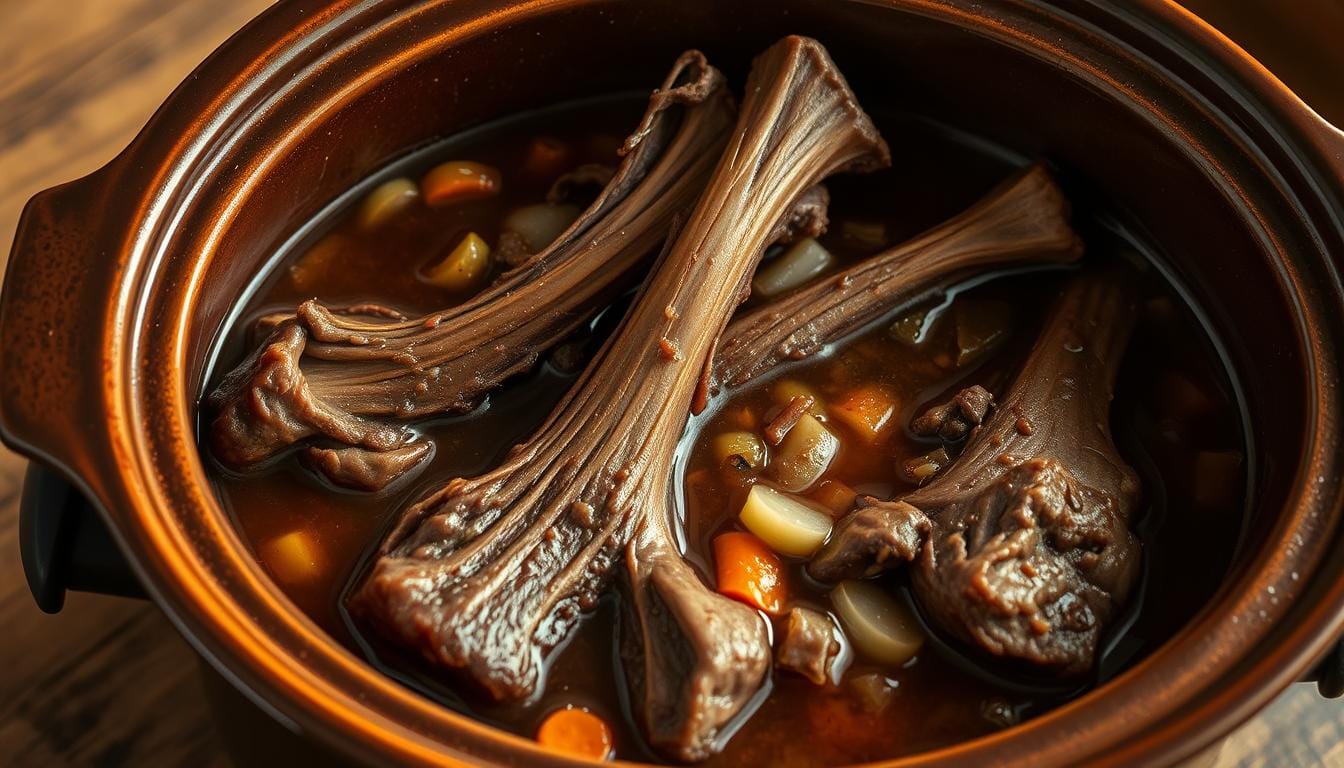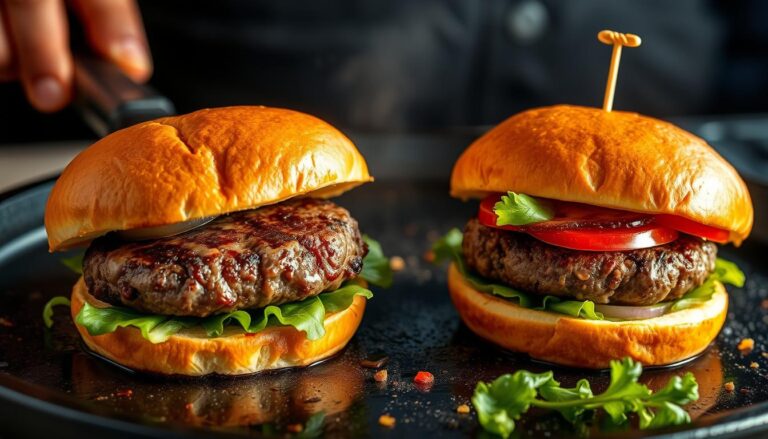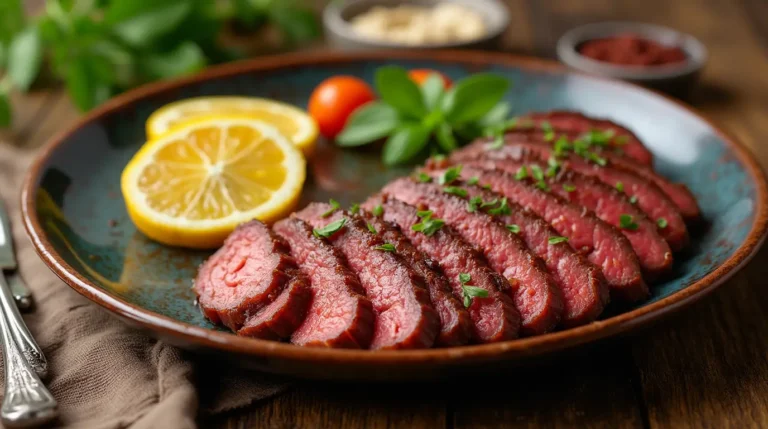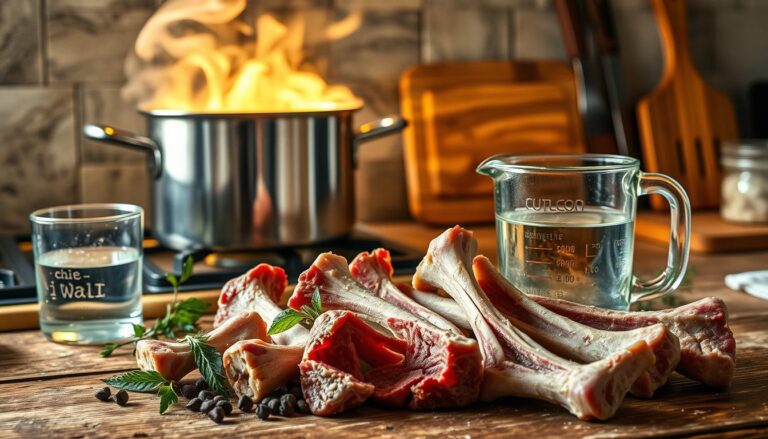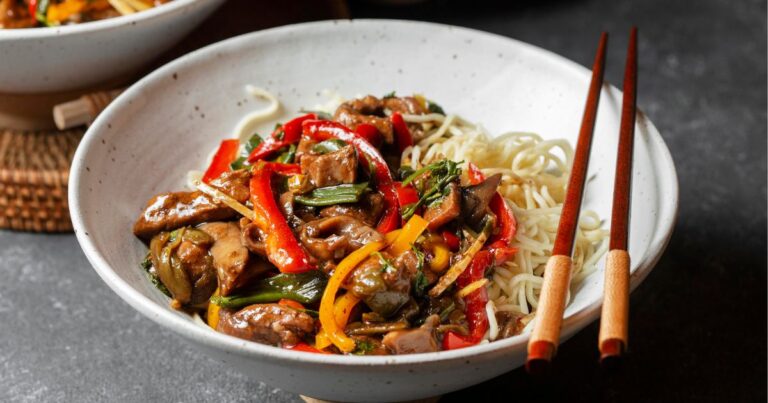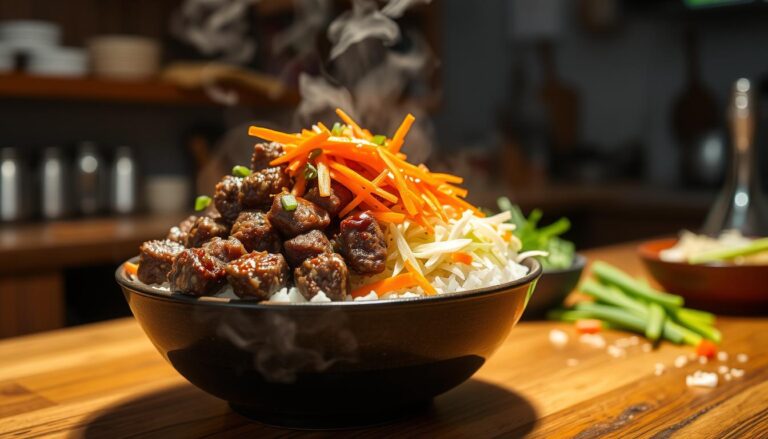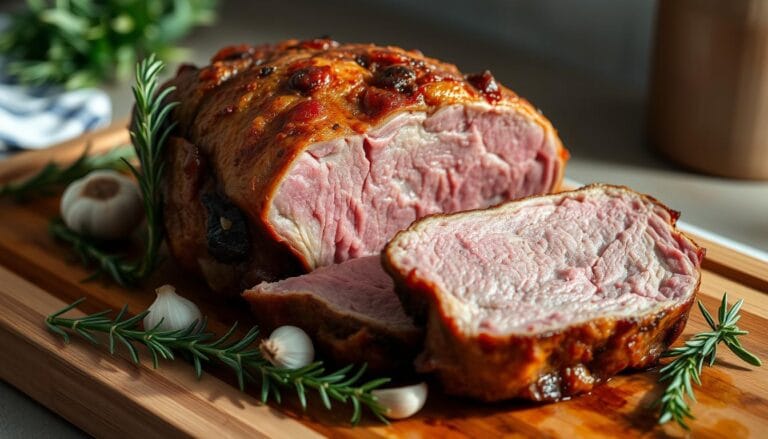Cook Beef Neck Bones in a Slow Cooker, A Perfect Recipe
Growing up in a Southern kitchen, I learned that simple ingredients make the best meals. Beef neck bones, a cheap cut, turns into a tender, rich dish. This shows the wisdom of traditional cooking.
Slow cooker recipes have made cooking easier for everyone. These beef neck bones are a great example. With a little prep and patience, you get a meal that’s both healthy and tasty.
If you’re always on the go or love cooking, this recipe is for you. It’s full of protein and rich flavors. These neck bones offer a meal that connects you to old cooking ways.
Ready to see how a slow cooker can make affordable beef neck bones into a delicious dish? It will impress your loved ones.
Table of Contents
Introduction to Beef Neck Bones
Beef neck bones are a hidden gem in cooking. They come from the cow’s neck and shoulder, giving a deep flavor. This makes them great for rich bone broth and hearty dishes.
Understanding beef neck bones is crucial. They are full of connective tissue and collagen. This makes them perfect for slow-cooking, breaking down tough fibers.
What Are Beef Neck Bones?
Beef neck bones come from the cow’s neck. They are:
- Inexpensive cut of meat
- Rich in connective tissue
- Excellent for making bone broth
- Packed with deep, robust flavor
Nutritional Benefits of Beef Neck Bones
Beef neck bones are a nutritional powerhouse. Here’s what they offer:
| Nutrient | Benefit |
|---|---|
| Collagen | Supports joint health and skin elasticity |
| Protein | Builds and repairs muscle tissue |
| Minerals | Provides calcium, phosphorus, and magnesium |
| Gelatin | Improves digestive health |
For those looking for authentic, flavor-packed dishes, beef neck bones are a great choice. They are affordable and nutritious, turning simple meals into amazing dishes.
Preparing Beef Neck Bones
Choosing the right beef neck bones is key for tender meat and tasty dishes. When you’re shopping, look for certain factors to make your meal delicious.
Understanding what makes beef neck bones special is important. Here are the key things to look for:
- Fresh, bright-colored meat with minimal discoloration
- Good meat-to-bone ratio (approximately 3 lbs for 4 servings)
- Visible marbling for enhanced flavor
- Bones with some attached meat and healthy-looking marrow
Selecting Quality Beef Neck Bones
For the best beef neck bones, go to a trusted butcher or meat counter. Ask about the meat’s source and choose grass-fed options. Grass-fed, grass-finished cattle provide more nutrient-dense meat.
Cleaning and Preparation Techniques
Cleaning your bones right is the first step to great flavors. Here’s how to prepare:
- Rinse bones thoroughly under cold water
- Pat dry with paper towels
- Trim excess fat if desired
- Remove any discolored or tough membrane
Experts say spending about 10 minutes on prep is worth it. Season with 1-2 teaspoons of Kosher salt to boost the flavor of your meat.
Essential Ingredients for the Recipe
Making a tasty beef stew with neck bones begins with picking the right ingredients. This meal is easy on the wallet but full of flavor and nutrition. Your slow cooker turns simple parts into a rich, hearty dish for a family of four.
Choosing the right vegetables and seasonings is key. They must match the strong taste of neck bones. The right mix can make your meal go from good to great.
Vegetable Selections
Your vegetable choices add depth and nutrition to the stew. Here are the essential ingredients:
- 3 medium carrots – for sweetness and color
- 2 celery ribs – adding earthy undertones
- 1 medium onion – creating a flavor foundation
- 3 garlic cloves – for aromatic intensity
Spices and Seasonings
Spices make your neck bones unforgettable. Your seasoning list should include:
- 1 tablespoon smoked sweet paprika
- 1/2 tablespoon allspice
- Salt and pepper to taste
Adding 2 cups of red wine and 2 cups of beef broth enhances the flavor. A 6-oz can of tomato paste adds depth to your stew.
Pro tip: Use 1 tablespoon of olive oil to sauté vegetables before adding them to the slow cooker. This step boosts the flavor of your dish.
Slow Cooker Setup
Getting your slow cooker ready is key to making tasty slow cooker recipes. The right appliance and setup are crucial for success. Let’s explore the essential steps to prepare your slow cooker for delicious beef neck bones.
Selecting the Right Slow Cooker
Choosing the right slow cooker is important for cooking beef neck bones. A 6-quart or larger cooker is best for 3-4 pounds of neck bones. Keep these points in mind:
- Ensure the slow cooker has a heavy, tight-fitting lid
- Check for consistent heat distribution
- Select a model with adjustable temperature settings
Preparing Your Slow Cooker
Proper preparation is essential for successful slow cooking. Here are some tips to set up your slow cooker:
- Spray the inner ceramic pot with non-stick cooking spray
- Check that the lid fits securely
- If the lid is loose, use parchment paper as an additional cover
| Slow Cooker Requirement | Recommended Specification |
|---|---|
| Size | 6 quarts or larger |
| Water Volume | 4 cups (950 ml) |
| Cooking Time (Low) | 8-10 hours |
| Cooking Time (High) | 5-6 hours |
By following these guidelines, you’ll create the perfect environment for tender, flavorful beef neck bones in your slow cooker.
Cooking Methods for Beef Neck Bones
Choosing the right cooking method is key to tender meat from beef neck bones. Different methods can turn this tough cut into a delicious dish. It will melt in your mouth.
Understanding beef neck bones is crucial. They have a lot of collagen, which needs special care to be tasty.
Comparing Cooking Techniques
Let’s look at the best ways to cook beef neck bones:
- Slow Cooking: The top choice for tender meat
- Braising: Great for breaking down tough tissues
- Pressure Cooking: Quick for those in a hurry
Why Slow Cooking Wins
Slow cooking is the best for beef neck bones. It uses low heat to break down collagen, making the meat tender. It takes 6 to 8 hours, allowing flavors to fully develop.
Slow cooking has many benefits:
- Maximum tenderness
- Rich, developed flavors
- Less hands-on time
- Nutrients are preserved
Braising and pressure cooking can work, but slow cooking gives the best results. The slow heat makes every bite tender and flavorful.
Step-by-Step Cooking Instructions
Mastering slow cooker recipes needs precision and care. When cooking beef neck bones, follow a detailed approach for the best flavor and tenderness. Understanding each step is key to success.

Before cooking, prepare your ingredients carefully. Brown the neck bones to add incredible flavor. Here’s a step-by-step guide to cooking delicious beef neck bones in your slow cooker:
- Start by seasoning the neck bones with salt and pepper
- Brown the meat in a hot skillet for about 5 minutes per side
- Transfer the browned bones to your slow cooker
Combining Ingredients Perfectly
Layering ingredients is crucial in slow cooker recipes. Create a flavorful base by adding:
- Chopped onions
- Minced garlic
- Carrots and celery
- Your favorite herbs and spices
Setting Cooking Time and Temperature
Cooking tips for perfect beef neck bones involve precise temperature control. Use these guidelines for optimal results:
| Cooking Method | Temperature | Cooking Time |
|---|---|---|
| Low Setting | Low (190-200°F) | 8-10 hours |
| High Setting | High (300-325°F) | 5-6 hours |
Pro tip: The longer, slower cooking method helps break down tough connective tissues, creating melt-in-your-mouth beef neck bones.
Remember to check the internal temperature of the meat, which should reach at least 145°F for safe consumption. Your patience will be rewarded with incredibly tender and flavorful beef neck bones!
Cooking Time and Temperature
Cooking beef neck bones well takes patience and the right timing. Slow cooking turns these tough pieces into tender, delicious meat. Your cooking tips will make a big difference in your meal’s taste.
Getting beef neck bones just right means knowing the best cooking time and temperature. Slow cookers are perfect for this meat. They help break down tough parts and add deep flavors.
Recommended Cooking Length
For the best results, follow these tips:
- Cook on low heat for 6-8 hours
- Aim for an internal temperature of 195-205°F
- Ensure meat is falling off the bone
Checking Doneness Like a Pro
To know when your beef neck bones are done, use these methods:
- Fork Test: Meat should easily pull apart with a fork
- Visual Inspection: Look for meat that has pulled back from the bones
- Internal Temperature: Use a meat thermometer to confirm doneness
“Patience is the secret ingredient to transforming tough neck bones into a melt-in-your-mouth delicacy.”
Nutritional highlights per serving show the value of slow-cooked beef neck bones:
| Nutrient | Amount |
|---|---|
| Calories | 326 kcal |
| Protein | 22 g |
| Fat | 14 g |
Remember, cooking low and slow is key to tender meat. It will impress your family and friends.
Flavor Enhancements
Turning beef neck bones into tasty dishes needs creative cooking and the right ingredients. Your slow cooker is perfect for making rich, deep flavors. These flavors will make your meal unforgettable.
To improve your bone broth and meat, focus on building flavors. It’s important to know how ingredients mix to create complex tastes.
Marinades and Sauce Techniques
When cooking beef neck bones, try these marinading tips:
- Use acidic ingredients like vinegar or wine to tenderize meat
- Add herbs like rosemary, thyme, and bay leaves
- Try umami-rich sauces like Worcestershire or soy sauce
Enhancing with Bone Broth
Bone broth is great for cooking beef neck bones. The gelatin and minerals from slow cooking add a lot of depth to your dish.
| Broth Type | Flavor Profile | Cooking Benefit |
|---|---|---|
| Homemade Beef Broth | Rich, Complex | Maximum Nutrient Retention |
| Store-Bought Beef Stock | Consistent, Convenient | Quick Flavor Boost |
| Vegetable-Infused Broth | Aromatic, Layered | Additional Mineral Content |
Pro tip: Let your beef neck bones simmer slowly in seasoned broth. This will enhance flavor and make the meat tender.
Serving Suggestions
Traditional cooking turns beef neck bones into a tasty meal. Your slow-cooked beef stew is full of rich flavors. It’s perfect for a cozy dinner.

Perfect Pairings for Your Beef Stew
Choosing the right sides can make your beef stew even better. Here are some tasty options:
- Creamy mashed potatoes
- Crusty artisan bread
- Buttered egg noodles
- Steamed white rice
- Roasted seasonal vegetables
Serving Style Recommendations
How you serve your beef stew matters. Pour the collagen-dense broth into wide, shallow bowls. This highlights the tender meat and colorful veggies.
| Serving Option | Description |
|---|---|
| Family Style | Large ceramic dish with side dishes around |
| Individual Plating | Centered meat with sides arranged artfully |
| Garnish Options | Fresh parsley, chopped chives, cracked black pepper |
Pro tip: Serve it hot to enjoy all the flavors. Your guests will love the effort you put into this comforting stew.
Storing Leftovers
After enjoying your delicious beef neck bones, it’s important to store them right. This keeps the flavor and ensures food safety. These tips will help you save money and avoid wasting food.
Cooling and Storing Techniques
Let your beef neck bones cool down completely before storing. Quick cooling stops bacteria from growing and keeps the meat fresh. Use shallow containers to cool food fast and fit in your fridge.
- Cool meat within 2 hours of cooking
- Use airtight containers
- Refrigerate at 40°F or below
- Consume within 3-4 days
Freezing for Long-Term Storage
Freezing helps your meal last longer. Wrap portions tightly in freezer-safe bags or containers. Remove air to avoid freezer burn.
- Freeze within 2 hours of cooking
- Use freezer-grade plastic bags
- Label with date and contents
- Freeze up to 3 months
Reheating Tips
When reheating, aim to keep the beef neck bones tender. Slow and gentle reheating stops drying and keeps flavor rich.
- Thaw frozen meat in the refrigerator overnight
- Use low heat when reheating
- Add a splash of broth to maintain moisture
- Stir occasionally to distribute heat evenly
Pro tip: Always ensure internal temperature reaches 165°F for safe consumption when reheating leftover beef neck bones.
Common Mistakes to Avoid
Learning to cook beef neck bones well means knowing what can go wrong. To get tender meat, you must pay close attention to a few key things while cooking slowly.
Cooking beef neck bones can be tricky. It’s easy to mess up and end up with a bad dish. The secret to a great meal is knowing how to avoid common mistakes.
Overcooking Risks
Overcooking is the biggest problem when making beef neck bones tender. It’s important to know the right temperature and how long to cook:
- Keep the cooking temperature between 185°F and 205°F
- Don’t let it get hotter than 205°F, or the meat will dry out
- Watch how long you cook it closely
Flavor Balancing Errors
Seasoning is key to making beef neck bones taste amazing. Here are some tips for getting the flavor right:
| Seasoning Mistake | Recommended Solution |
|---|---|
| Under-seasoning | Add salt early in cooking process |
| Too much liquid | Use 1½ teaspoons flour per cup of liquid for thickening |
| Weak flavor base | Use beef stock instead of water |
By steering clear of these common errors, you’ll be more likely to make perfectly cooked beef neck bones. They’ll be both tasty and tender.
Conclusion and Final Thoughts
Exploring beef neck bones through slow cooker recipes opens up a new world of flavors. Grass-fed beef neck bones are packed with nutrients, making them a great choice for a tasty meal. By learning these slow cooker techniques, you can make tender, delicious dishes that wow everyone.
Slow cooker recipes for beef neck bones let you make restaurant-quality meals at home. The slow cooking method makes the meat tender and flavorful. Remember, patience is key. Cooking the beef neck bones for 6-8 hours on low heat makes them extra tender and tasty.
Don’t be afraid to try different seasonings and cooking methods. Whether it’s a hearty stew or a fancy braised dish, beef neck bones can make your cooking stand out. With practice, you’ll become a pro at turning this humble cut into a dish that’s both delicious and healthy.
Your Culinary Adventure Begins
Your adventure with beef neck bones is just starting. Each recipe is a chance to get better, try new flavors, and make meals that people will remember. Start cooking, stay curious, and enjoy the tasty results of your slow cooker adventures.
FAQ
What are beef neck bones, and why are they good for slow cooking?
How long should I cook beef neck bones in a slow cooker?
Can I freeze beef neck bones before cooking?
What are the best seasonings for beef neck bones?
Are beef neck bones nutritious?
How can I prevent beef neck bones from becoming too greasy?
Can I use beef neck bones in other recipes?
What’s the best way to check if beef neck bones are fully cooked?
Did You Try This Recipe ?
There are no reviews yet. Be the first one to write one.

